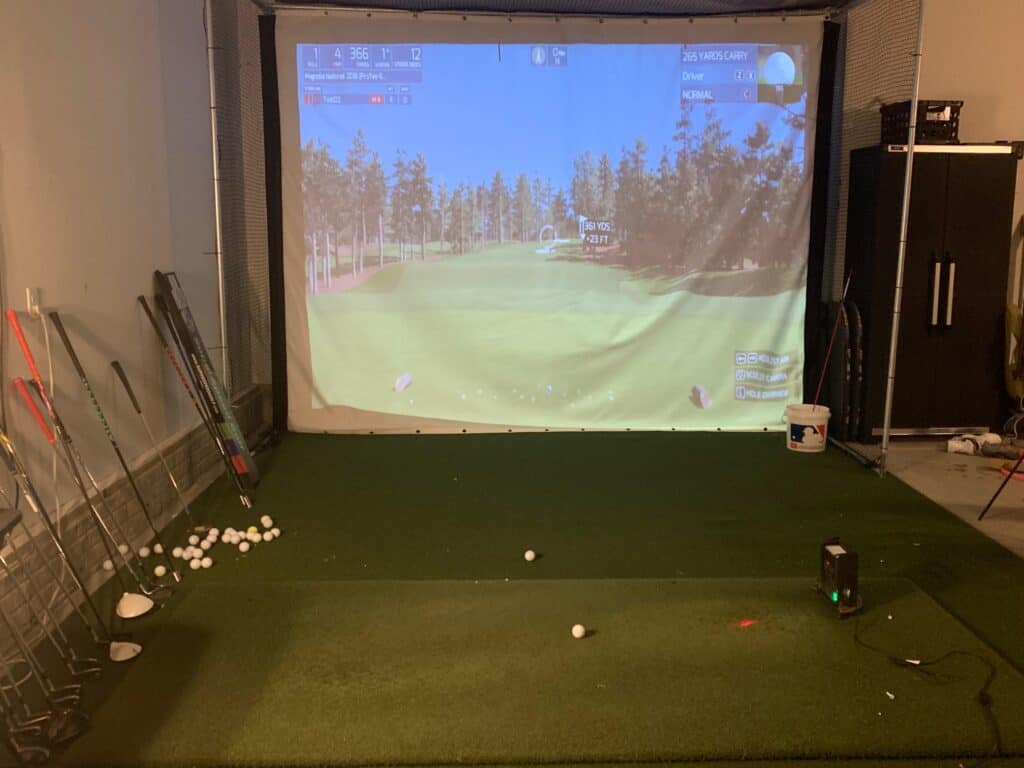One of the most frustrating shots in golf is when the wedge shot comes up short.
There you are in the fairway, setup with a great look at the pin, only to have the golf ball come up 5-20 yards short.
You might end up with a long putt, in a bunker short of the green or in the worst case scenario in a water hazard.
If this sounds like your situation from time to time, you might want to check out the reasons why and the solutions we provide!
Why Do I Hit My Wedges So Short?
There are several potential reasons that include poor ball striking, too much loft at impact or a lack of knowledge of how far you actually hit the wedges in your bag.
Below, I will dive into each reason and at the end of the section provide the solution for each reason.

Reason #1:Poor Ball Striking
The number one fundamental in golf is being able to strike the ball solidly.
Too many golfers struggle with this fundamental even years after playing the game. It all comes down to their low point control in the swing.
Oftentimes, the weight shift fails to get far enough to the front side, leaving the golfer behind the ball and the club bottoming out prior to getting to the ball from a slight cast to try to assist the motion.
When the ball is not struck solid, it is going to come up short of the distance you think you hit the ball. The more frequently you can strike a ball solid, the most frequently it will travel the intended distance assuming you read your lie correctly, anticipated the impact on the wind and actually know how far you hit each club in your bag.
Solution #1: Low Point Control Drill
This is one of my go to drills with many golfers that I work with. The goal here is to learn to control your low point to increase the quality of your strike!
The Low Point Control Drill
- Take some yard paint and paint a 1-2 yard long line.
- Setup with 55% of your weight on your front side.
- Try to hit the target side of the line and see how many times out of 10 you can do this successfully!
- Repeat this drill every day for a month, tracking your progress and your ability to do this successfully in trials of ten.
- You may need to start with half swing and progress to full swings.
If you are struggling, put more weight forward and work on keeping your head still to help control the low point in the swing.

Reason #2: Too Much Loft At Impact
Did you know that the average launch angle with pitching wedge on the PGA Tour is around 24 degrees of loft?
Most pitching wedges are between 46 and 48 degrees, yet the launch angle is just about half of the loft. What does this mean? It means that the pros are delofting their clubs to help compress the ball and hit it solidly without throwing the ball way up in the air.
Many amateurs do the opposite and cast the club early and add loft at the bottom of the swing causing the ball to fly too high and too short of the intended target. This can be devastating.
Solution #2: Deloft Your Club and Get Your Hands Forward
I have come across a training tool that I believe is great for ensuring that you aren’t casting the club from the top and that you are actually compressing the shot. The club I use to keep my swing nice and shart is the DST Club.
Reason #3: Lack of Knowledge of True Distance
Unfortunately, too many golfers have too big of egos. They feel like they have to hit their driver 275 yards, hit their 8 iron 160 yards and hit their sand wedge 110 yards. When in reality if they kept the ball in play and controlled their true distance, they would score much better than always trying to get the 5 extra yards.
Too many golfers think they hit the ball further than they actually do. We can all be guilty of this until we are ready to set the ego aside and actually measure your distance with each club in the bag!
Solution #3: Map Your Bag!
I would highly recommend each golfer create a distance chart like the sample below:
| Club | Carry Distance (100%) | 90% | 80% |
| 2 Utility Iron | 210 | ||
| 4 iron | 190 | ||
| 5 iron | 181 | ||
| 6 iron | 171 | ||
| 7 iron | 163 | ||
| 8 iron | 153 | ||
| 9 iron | 143 | ||
| P Club | 130 | 123 | 115 |
| Pitching Wedge | 118 | 110 | 102 |
| SW Club | 105 | 97 | 91 |
| LW Club | 90 | 82 | 74 |
This might be the most important information you can use to help you play quality golf. I have heard so many stories and have seen it first hand where golfers completely over estimate how far they hit each iron.
They hit one 7 iron 165 yards one time and think this is their carry distance. So they step up to a 165 yard shot, hit the 7 iron and end up in a bunker. They blade it out of the bunker and are looking at a double bogey as their reality. Instead, if they had the right club and hit the 6 iron, their chance of hitting the middle of the green would increase greatly!
How can you create your own chart?
Best Option: I would highly recommend a launch monitor!
These portable devices can be used at the driving range, golf course or set up in your home net or golf simulator. These devices are game changers not only on being able to map your bag and know your distances, but they also provide quality feedback after on every shot and provide the following information:
- Carry Distance
- Spin Rate
- Launch Angle
- Spin Axis
- Total Distance
- Ball Speed
This information will help you map your bag, decide on which clubs are best for your game, develop a stock shot and much more. I love using my SkyTrak 365 days a year in my golf simulator setup.
The process for mapping your bag can looking something like this:
- Hit 5 shots with each club in your bag.
- Log the carry distance and total distance for each shot.
- Eliminate any outlier numbers (poor hits or low spin rates).
- Take the average and create a map of your bag.
If you visit any PGA Tour event you will see plenty of golfers utilizing their launch monitors. While most can’t afford a Trackman, there are some very affordable options in the 500-2000 dollar range. I own the SkyTrak and think the world of it.
Here are the top 3 options to check out:
Related Posts
- Why do I hit my wedges fat?
- Why do I push my wedges?
- Why do I pull my wedges left?
- 54 vs 56 degree wedge

My Secret To Golf Improvement
Let’s face it, in order to get really good at golf, we must practice frequently. About three years ago, I made the leap and invested in a golf simulator build for my garage. I went with a SkyTrak Launch Monitor and the TGC software and can now play over 100,000 courses including Augusta, Pebble Beach, Bethpage Black, Whistling Straits. St. Andrews and many other of the top 100 courses in the world.
This golf simulator setup, which is more affordable that you might imagine, has been a game changer. I can now play golf everyday of the year regardless of rain, snow, cold weather or time of day. I can practice or play rounds of golf. I can stand in the 11th fairway at Augusta and with the auto-rewind feature I am able to practice my approach shots from various differences.
It is worth checking out through Rain or Shine Golf as they offer some incredible packages along with financing offers that are difficult to beat.
Some direct links to Rain or Shine Golf for pricing and financing:
Take Action – What You Can Do Today to Get Better
What does this mean for you? I believe in the following recipe to get better:
1 – Improve your motion in the golf swing by identifying a golf instructor. Here are some options:
Here is a list of golf instructors that we have reviewed:
2 – Train to swing faster and improve your swing speed. Here are some options:
Looking to gain more Speed and Distance in your swing. Two Options:
3 – Understand course strategy and work to break through your next barrier. Here is a series on breaking through:
We have provided guides on how to break 100, 90, 80 and 70. Check out more below, if interested.
4 – Practice Frequently
Did you know that I build a golf simulator in my garage and have played over 500 rounds of golf on my SkyTrak system? It has been a game changer and one worth checking out. Here are some of my other posts on golf simulators frequently asked questions:
- Is a Golf Simulator Worth It?
- How to Build a Golf Simulator?
- What is the Best Golf Simulator?
- Golf Simulator Accessories?
- How to Build a Golf Simulator for under $7000
- Top 11 Reasons to Buy a SkyTrak
- How to Build a Golf Simulator for Under $1000
- Why Build A Golf Simulator?
- What Space is Needed?
- Can A Golf Simulator Improve My Game?
- How Much Does A Golf Simulator Cost?
- Don’t Forget to Check out our 15 best golf swings of all time.
